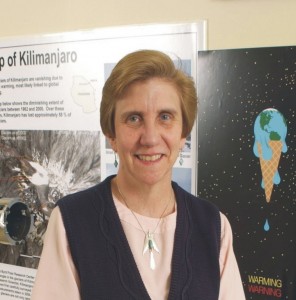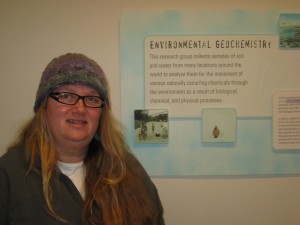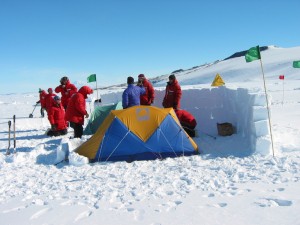Have you ever wondered what it would be like to work on an ice sheet in Antarctica or on the Arctic sea ice? Polar researchers must be able to function in remote locations and deal with cold temperatures, high winds, and blizzard conditions. They do so by completing survival training and by adopting strategies and behaviors similar to those of polar animals.
Researchers: Ellen Mosley-Thompson, Terry Wilson, Kathy Welch, Mary Davis
University/Organization: The Ohio State University, Byrd Polar Research Center (BPRC)
Research Location: Antarctica and other cold places
MEET THE RESEARCHERS
As the education and outreach coordinator for the Byrd Polar Research Center at Ohio State University, I’ve had the opportunity to learn from four researchers who have each traveled to cold environments many times. I also experienced being out in the field when I went to Antarctica in December 2003 to photograph, videotape, and interview research teams affiliated with the Long Term Ecological Research Network. They conducted their studies in the McMurdo Dry Valleys, an area approximately 2 per cent of Antarctica that is not covered by snow and ice. During the next semester, my students and I used the information gained from my trip to construct a CD set to help others understand the ecology of this extreme environment.
 |
Ellen Mosley-Thompson is a world-renowned paleoclimatologist who has drilled ice cores from numerous field sites on both Greenland and Antarctica ice sheets. She and her team study the annual layers of ice in the cores, from which they can deduce past climate conditions for that region. She will return to Antarctica in December 2009 with the LARISSA project (LARsen Ice Shelf System, Antarctica), funded by the National Science Foundation (NSF), to drill an ice core about 500 meters (1,640 feet) long through the ice field on the Bruce Plateau. |
 |
Terry Wilson is the principal investigator for the United States in the Polar Earth Observing Network (POLENET), another NSF project. A geologist, Terry has been to Antarctica 15 times, for a total of about 13 months. She was one of the research scientists on the ANDRILL (Antarctic Geological Drilling) program in which teams drilled through the Ross Ice Shelf into the ocean floor of McMurdo Sound to learn more about Antarctica’s geologic history. |
 |
Kathy Welch is a geochemist who conducts research with the McMurdo Dry Valleys Long Term Ecological Research group in Antarctica. Kathy will spend her 18th season at McMurdo Station this field season (November to February). Traveling to the McMurdo Dry Valleys every year to collect water samples, she is very familiar with field safety procedures and their importance. She has also spent two field seasons in Greenland. |
 |
Mary Davis is a research associate with the Ice Core Paleoclimatology group at BPRC. Mary has completed 14 expeditions to mountainous regions on four continents. Instead of traveling to polar regions, Mary works at high elevations (above the snow line) where the air is thin. These research sites are often hundreds of miles from any organized form of support, so the team must be as self-reliant as possible. |
Each of these researchers has had multiple experiences in harsh climates and is confident of her ability to assist the team when conditions change. Each of them offered anecdotes and observations from their in-the-field research.
Who needs survival training?
I grew up in northwestern Wisconsin and thought I understood cold temperatures, wind chill, and hypothermia. In 1964, when I was in the seventh grade, the temperature remained below 0 degrees Fahrenheit for a full month! It would go from minus 28 to minus 6 and then down to minus 32 and up to minus 10. I thought I had sufficient experience with cold temperatures to know what I was getting into when I agreed to go to Antarctica in 2003. However, it’s different when you’re far away from a heated house or car; survival is at stake!
Researchers who work in the polar regions, or at high elevations that are equally harsh, must be self-aware and self-sufficient. When I arrived in Antarctica, my first checkpoint was Survival School, also fondly referred to as “snow school” or “happy camper school.”
SURVIVAL School
All researchers who receive support from the National Science Foundation (NSF) to study in Antarctica must undergo survival and waste management training before they are qualified to leave the field station perimeter. Survival School is a tent-camp overnighter on the Ross Ice Shelf. It addresses the basics of heat loss in a cold environment, as well as strategies to avoid danger and assist others, if necessary.
Each person practices tying knots and helps to pitch a tent and make a wind wall with blocks of snow. They’re taught the proper way to enter and exit the tent, lay out their sleeping bag, and dry their clothing. They must also demonstrate that they can set up and light small gas stoves for cooking. All are taught how to set up and troubleshoot a two-way radio system, as well as how and when to report back to the base station.

A mountain tent pitched behind a wind wall made of snow blocks (top). The cook stove (bottom) is set up on a “snow shelf” behind the wind wall.
It’s important to train the teams quickly so they can be deployed to their research sites as soon as possible. I was there in December (already well into the Antarctic “summer”), and it was mild and sunny during my snow school experience. Therefore, we put buckets over our heads to simulate the lack of visibility and the difficulty we would have hearing each other during a white-out storm with high winds and blowing snow.
Completing survival training is a real confidence-builder. Weather conditions can change very quickly in Antarctica. We understood that we had to be responsible in our choices so as not to endanger others and be fully prepared to help others when necessary.
Learning from our animal friends
Some survival strategies are based on common sense, and others are based on observations of animal behaviors. For example, many animals huddle behind a tree or rock, or crouch low to the ground, in cold and windy conditions. This behavior reduces the area of the body that is exposed to the wind, reducing the wind-chill effect.
Snow is a good insulator, and some polar animals survive the coldest part of the winter in a snow cave. Ptarmigans, an Arctic bird, will fly head first into a soft snowdrift, creating a temporary shelter. If strong winds develop quickly and researchers don’t have time to pitch their tent, they have been taught to create a dugout. The snow will drift over them, creating an insulating layer, and they’ll be protected from the wind chill, as well.
Survival school at McMurdo Station in Antarctica also includes learning how to build a quinzhee. This is done by piling all the gear bags and other survival equipment in one place and packing snow over the pile to an adequate thickness- at least the length of the handle of an ice axe. Then a hole is dug through one side of the domed pile of snow and the bags are removed, leaving a hollow space inside. A second hole is cut into the wall to provide air circulation. The quinzhee is an artificial snow cave large enough for a few people. It is comfortable because the wind can’t penetrate the packed snow. Body heat is trapped inside, moderating the temperature. Properly constructed, the quinzhee is a safe and sturdy structure.
EXTREME COLD WEATHER GEAR
Researchers in Antarctica are issued extreme cold weather gear, which includes a lightweight inner jacket, bib overalls, a heavy parka, gloves, mittens, and insulated boots. It’s important to have gear that fits properly. Each person must try on each piece of clothing and check the zippers and other features to assure that they will work. Researchers who travel to remote field camps are expected to dress appropriately for the conditions and have a change of clothing in their backpacks, in case their clothing gets wet.

This photo shows the types of extreme cold weather gear issued to scientists preparing to travel to Antarctica.
A special type of boot, nicknamed “bunny boots,” is required when traveling by air across Antarctica. These rubber boots have air spaces that act as insulation. Since air pressure falls as the plane or helicopter gains altitude, the air inside the wall of the boots expands. This can make your feet feel like they’re being squeezed. The boots have an air valve to release some of the pressure when the plane reaches altitude. Although bunny boots are heavy and a bit cumbersome for walking, they have been determined to be the best protection against extreme cold.
FUR, FEATHERS, AND LAYERS
Layers of air are a great insulator. Animals with fur have many air spaces distributed among the hairs on their bodies. Air in these spaces is warmed as heat radiates from their skin. Some furry animals have two layers of hair in their coat. A dense layer of short hair lies close to the skin and a layer of longer hair acts like a shield or umbrella, keeping the wind and moisture from penetrating the shorter hair layer.
Feathers are also good insulators because they have many small air spaces in their structure. We use feathers in down-filled jackets and comforters. You may have noticed that birds fluff their feathers outward, looking a little more plump than usual, when it is very cold. This allows extra air spaces between the feathers, in addition to the air spaces within the structure of the feather itself.
Layers of fabrics provide the same benefit for humans that feathers and fur offer to animals. Modern fabrics have microfibers and uniform air spaces to provide insulation, like the shorter hair layer in fur. We add or remove layers of fabric to regulate our temperature.
DRY IS WARM(ER)
You know that even on a warm day, you may shiver when you step out of the pool if there’s a breeze. Evaporation of water is a cooling process, and wind accelerates the rate of evaporation. So it’s important to stay as dry as possible in cold temperatures.
Animals that live on or in the water benefit from a water-repellant layer of feathers or fur. Waterfowl, like ducks and geese, have an oil gland near the base of their tail. The birds spread oil over their feathers with their beaks when they groom themselves, or “preen.” Mammals such as otters and beavers also use oil as a water repellent. They have an oil gland at the base of each long hair. The oil is distributed over their fur when they groom themselves.
Kathy Welch recalled, “There were a couple of occasions when I did get cold with mild hypothermia and it was primarily because I got wet. One time I was on an extended hiking trip on the coast of Greenland and it rained and snowed. We were not well prepared for the conditions. Another time I broke through the ice on a meltwater pond on the surface of Lake Fryxell, Antarctica. All of my spare clothes in my backpack got soaked too because I went in up to my chest. It was a warm sunny day with no wind, so we decided we could risk staying out on the lake to do our work. As long as I kept working and moving I was OK; but I did get cold by the end.”
A LAYER OF BLUBBER
Marine mammals (such as whales, porpoises, walruses, seals, and sea lions) have a layer of fat under their skin, called “blubber,” which is an excellent insulator. Some of these animals live their entire lives in cold water. Others, like whales, migrate into areas of cold water, and dive to depths where the water temperatures are near the freezing point.
Wet suits help divers retain body heat when working in the water, especially where the water is cold and hypothermia would result. Neoprene, a spongy synthetic rubber used for wet suits, has many tiny spaces that trap water close to the body. This layer of warm water prevents the colder water from circulating directly in contact with the diver’s skin, reducing heat loss. Some heat is lost, but the generation of muscle heat from the exertion of swimming compensates.
Wet from the inside out
We humans perspire when we’re working hard. Sometimes just carrying a backpack of equipment and survival gear while hiking up steep slopes can cause researchers to sweat, even in very cold conditions. They say cotton is not a good choice for undergarments because it absorbs and retains moisture. Underclothes made of wicking fabrics carry moisture away from the skin.
Eating to stay warm
Ellen Mosley-Thompson described what it was like to live for weeks at a time at temperatures well below the freezing point of water. Just to prepare their next meal, someone on the team had to melt enough ice to rehydrate and boil or steam their food.
I was surprised by how much food Ellen said she would eat at a typical evening meal while living “on the ice.” The meals usually consisted of pasta with vegetables and meat – usually beef – plus crispbread with honey, peanut butter or jam, nuts, dried fruit, and hot tea to drink.
Ellen’s typical meal reminded us that we require more food than usual in a cold environment, just to maintain our normal temperature. Even more food is necessary if we are going to do work! Because she had become accustomed to eating large portions and didn’t want to gain weight, Ellen consciously took smaller portions at each meal while traveling back to the States.
Because chocolate is rich in calories, researchers are given chocolate candy to carry in their backpacks when they go away from camp. It’s a quick and tasty energy source.
When asked if they really felt warmer after eating chocolate, three of the women said that they didn’t. Terry Wilson said, “Definitely not. But it tastes good anyway–unless it is frozen, in which case it doesn’t have much flavor. I try to always warm my chocolate up in an inner pocket before I eat it.” Mary Davis said, “I don’t feel warm after eating chocolate, but I do after drinking hot cocoa (but not hot tea, for some reason).”
Hot water bottle
When I’m cold in my office, a hot beverage can make me feel warm quickly. It “warms the core”-putting a warm substance in contact with the blood vessels of the stomach. This signals the brain that the blood returning to the internal organs is warm enough. Or I can place a hot water bottle on my lap, which warms the blood in the large arteries in my legs. The warmed blood circulates quickly throughout my body and I feel warmer almost immediately.
However, in remote field locations, the researchers are far from a microwave or a hot cup of tea. But they do have a warm liquid readily available to them! In Antarctica, when scientists are away from the field station, they are required to urinate into a bottle, because human waste cannot be released into the environment. They must bring all wastes, including their liquid waste, back to the camp, where it is returned to the main station for processing. Since our urine is at body temperature, or about 98 degrees, carrying your pee bottle in a jacket pocket instead of stowing it in your backpack is like having a very personal hot water bottle.

Chad Hoare (a puppet made by one of the research station managers) with his pee bottle. The puppet is named for Lake Chad and Lake Hoare, two of the lakes in Taylor Valley, one of the McMurdo Dry Valleys where the LTER team conducts research each year.
Voices of experience
The four researchers all stressed the importance of having a good insulation layer between the sleeping bag and the ice or snow below. Mary said, “When we pack to go to what we know will be a very cold glacier, like in Alaska or in the Himalayas in the autumn, I include an extra sleeping bag and a liner for myself.”
Mary stands on snow or ice for hours at a time, logging data about the ice cores the team retrieved, and her feet understandably get cold. She said, “I have used chemical heating packs stuck in my gloves (while I work) and jammed down in the toes of my socks (while I’m sleeping). Of course, since these packs react to air, at high elevations where the air is thin, they aren’t as effective as they are at sea level. But, any warmth is better than none.”
Mary added, “Since batteries tend to drain faster in extreme cold and instruments often seize up, I share my sleeping bag at night with my camera, my CD player, my flashlight, and any spare batteries I have.”
Terry said she hasn’t used the chemical heating packs yet, but she has seen advertisements for boots with a toe heater and a recharge plug built into the heel. Kathy said she has used a water bottle in her sleeping bag in the tent, to add warmth. She added, “I am getting ready for my 20th polar field season. Looking back on all of those trips, there were not many times that I was very cold, and that is a good thing. That’s the way it should be.”
This article was written by Carol Landis. For more information, see the Contributors page. Email Kimberly Lightle, Principal Investigator, with any questions about the content of this site.
Copyright December 2009 – The Ohio State University. This material is based upon work supported by the National Science Foundation under Grant No. 0733024. Any opinions, findings, and conclusions or recommendations expressed in this material are those of the author(s) and do not necessarily reflect the views of the National Science Foundation. This work is licensed under an Attribution-ShareAlike 3.0 Unported Creative Commons license.






